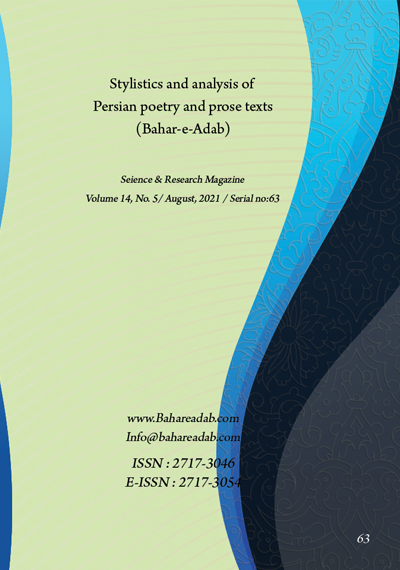- Count View : 419
- آدرس کوتاه شده مقاله: https://bahareadab.com/article_id/1122
- کد doi مقاله: Doi: 10.22034/bahareadab.2021 .14 .5483
Journal of the stylistic of Persian poem and prose
volume Number 14،
number In Volume 5،
،
issue Number 63
A Study of Islamic Elements and References in the System of Weiss and Ramin
Fahimeh Sazmand , Hadi Khadivar (Author in Charge), Shahrouz Jamali
Abstract
BACKGROUND AND OBJECTIVES: The lyrical poem "Weiss and Ramin" belongs to pre-Islamic times and was composed in the Islamic period. Although this system is full of elements and references to pre-Islamic Iranian culture and religion; But Fakhreddin Asad Gorgani, due to being a Muslim, has referred to Qur"anic allusions and moral-Islamic themes in this poem. In fact, this kind of attitude of Fakhreddin arises from his religious beliefs. In this article, the elements, themes and Islamic allusions in this fictional system are analyzed and explained. This research is an attempt to show the place of Islam in the lyrical system of Weiss and Ramin.
METHODOLOGY: This research was conducted by descriptive-analytical method and content analysis and in order to collect information from the library method used.
FINDINGS: Items such as praising God with the attributes discussed in Islamic sects, the narration of the Holy Prophet (PBUH), Quranic teachings, sacrificing cows and the like are some of the references related to the religion of Islam in this system.
CONCLUSION: The intellectual and moral system in Weiss and Ramin"s system is based on religious beliefs. This poem contains Islamic references due to its composition in the Islamic period and due to the subject and root of the story, it contains the teachings and teachings and beliefs of ancient Iran, especially Zoroastrianism. Fakhreddin, who in the introduction of his work and in the section "Praise of God" by referring to issues such as denying the vision of God and rejecting the belief of the similes, proves to be a Mu"tazilite to some extent, although he has been forced to express Mazdisna religious topics and allusions. Due to his being a Muslim, there are many references to the principles of Islam in his work.
Keyword
Weiss and Ramin
, Intellectual level
, Religion
, Islam.
- The Holy Quran.
- Ashtiani, Jalaluddin. (1988). Zarathustra: Mazdisna and the government, Tehran: Publisher Company, p. 230, 258.
- Boyce, Mary. (1996). History of Zoroastrianism, Translated by Homayoun Sanati, Tehran: Toos, p. 228.
- Gatha. (1999). Pourwood, Ebrahim, Tehran: Myths, p. 115.
- Gorgani, Fakhreddin Asad. (2010). Weiss and Ramin, Edited by Mojtaba Minavi, Tehran: Hirmand.
- Hedayat, Sadegh. (2000). A few points about Weiss Varamin, in scattered writings, compiled by Hassan Ghaemian, Tehran: Sales.
- Ilise, Sibert. (2000). Woman in the Ancient East, translated by Roghayeh Behzadi, Tehran: Pazhuhande, p. 13.
- Moghaddam, Mohammad. (1996). Essays on Mehr and Venus, Tehran: Studies of our culture, p. 56.
- Mohaghegh, Mahdi. (1957). Notes on the system of Weiss and Ramin, Yaghma Magazine, Volume 10, Number 12, pp. 417-421 and No. 13, p. 461.
- Musharraf, Maryam. (2010). Essays in Iranian Educational Literature, Tehran: Shahid Beheshti University, p. 9.
- Sattari, Jalal. (1994). The image of women in Iranian culture, Tehran: Markaz, p. 11.
- Sharifi, Gulfam. (2005). Ancient Iranian Perspectives on the Problem of Algebra and Authority, Iranian Studies of Shahid Bahonar University of Kerman, Fourth Year, No. 7, pp. 149-173.

